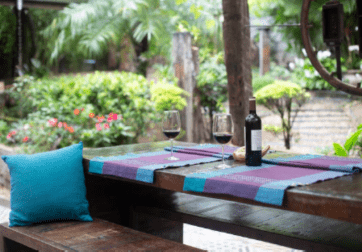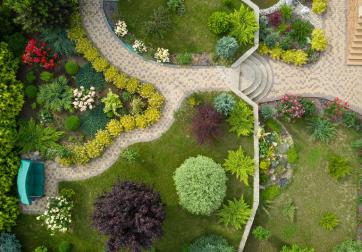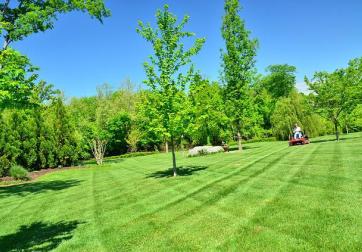Landscape Design
LANDSCAPE DESIGN TIPS FOR EVERYONE
Whether you are landscaping a new home or renovating older plantings this spring, here are a few points to consider.
- Always start planning on paper. It’s a lot easier to use an eraser than a shovel.
- Paths and driveways should be straight, direct routes unless there is a good reason for them to be otherwise.
- Trees should be used to frame the house and provide a background. They should not block or hide the house. Whatever you do, DO NOT plant a Bradford Pear tree anywhere – they are trash trees!
- Do not over plant. Be sure you know how big the plants will get and don’t plant too close together.
- Confine specimen plants to the perimeter of the lawn area, especially if you have a small yard. Open lawn will look spacious and be a lot easier to mow.
- Watch the scale of the plantings. If you have a small house and a small yard, large plants can overwhelm everything.
- Create focal points and centers of interest. These can be outstanding plants, a view, a pergola, or tasteful statuary. The entry is the usual focal point in front. Have a focal point in the back yard also.
- Statues, benches, and water features can be used as focal points; however, choose them carefully and don’t use very many.
- In order to make the entry welcoming, do not put large shrubs near the door. Use larger shrubs or small trees near the corners of the house and gradually taper them to lower ones near the door.
- In general, do not depend on a foundation planting of only perennials, annuals, and roses in front of the house. You need some evergreens for winter color and interest.
- You don’t have to plant the whole foundation of the house. Foundation plantings were originally used because houses had tall, ugly foundations that needed to be hidden. Groundcovers between shrubs will tie the plantings together.
- Don’t put all your best plants against the foundation where only the neighbors can see them. Plant for your enjoyment by putting plants where you can enjoy them from your windows.
- Usually plants with fine texture are better placed in the foreground and coarser materials with larger leaves are better placed in the background.
- Border plantings can be used alone or in conjunction with fences to define property lines and achieve needed privacy and make it quieter. This is the perfect place to plant native plants to attract birds and butterflies and you can enjoy them from inside as well as from your yard.
- When planning your landscape, do not overlook shrubs with outstanding winter color, branch habits, or fruit. Plan for year-round effect and pick plants that bloom at different times.
- Select plants that will grow well in your area – depend on native plants in from your area.
- Consider the color scheme but don’t stress too much over it. Nature seems to make most colors look good together. You can pick a cool palette of blues, pinks, and lavenders or a warm palette of reds, yellows, and oranges. You can even use both by separating them with white or having them in different areas. The only color combination that really bothers me is Taxi Cab Yellow and Pepto Bismol Pink together. However, if you like that, it’s your yard, so go for it.
- Simplicity is the key to good design. You don’t want to have cluttered plantings or shrubs scattered around the lawn without being part of a bed or border.
- Keep everything mulched. Use a good organic mulch 3-4 inches deep around plantings. Mulch not only makes the plantings look better, it keeps weeds down, keeps the soil cooler in summer, conserves moisture, keeps soil from splashing on plants, and improves the soil as it breaks down.
- DO NOT use weed barrier landscape fabric in beds or borders. Not only does it not work to keep weeds out, it makes it harder to get rid of them. It is almost impossible to add new plants to your garden since you have to remove soil, cut a hole in fabric, and try to shove a plant into the hole. Meanwhile, you have exposed weed seeds that will sprout along with all the seeds birds and the wind have deposited on top of the soil above the fabric. Trying to pull Bermuda grass runners (the fabric does not even slow them down) is a nightmare that will likely dislodge your ornamental plantings and expose the ugly fabric. It does not break down, and it will haunt you forever – enough said!
- The most important thing in designing a landscape is to have something you enjoy and that works for your family and location. Something as simple as having water faucets readily available and a place to keep your tools handy makes gardening more enjoyable.
- Put a bird feeder in the back yard and keep it filled with black oil sunflower seeds to attract many different species of birds. Hang a few nectar feeders for hummingbirds on different sides of the house, and put a shallow birdbath with a pump to circulate water to attract birds.
- Put a small sitting area under a shade tree so you can take a break from weeding and enjoy the beautiful view you have created.
Stay Safe & Happy Gardening!
Pat Neasbitt, Master Gardener
1 Comments
Landscaping By G. Pellegrino
by
john
on Mon, 01/15/2024 - 00:36
All the information that you shared with us about Online is very useful and important. Thank you .

 Board Member Login
Board Member Login Our Store
Our Store Blog
Blog





